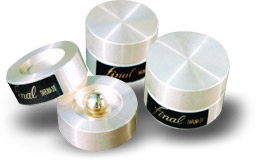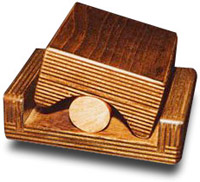![[SoundStage!]](../titles/sslogo3.gif) Home
Audio Home
Audio Equipment Review |
||||||||||||||||||||
July 2001 Final Laboratory Daruma 3-II Isolation Devicesby Doug Schneider
I have to admit that even after using these devices for quite some time, I'm not completely sure how to pronounce their name. "Da-roo-mah," I would guess. Then there is the suffix -- 3-II. "Three, two," perhaps. Or maybe "Three-eye-eye." Heck, I don’t really know. What I do know now, thanks to the manufacturer, is that the name Daruma comes from "a Japanese doll that brings luck and happiness." The Daruma 3-II devices from Final Laboratory of Japan are effective tweaks that don’t cost all that much -- $99 USD per set -- something that’s important to me. See, I’m not all that much of a tweaker. If it isn’t easy, chances are I won’t do it. If I have to use an arsenal of tools to set something up, I don't want to bother. And if I have to spend more than the cost of a week at a tropical resort just to effect a minuscule change in sound, I won’t lay out the cash. A tweak has to offer noticeable, easy-to-attain, cost-effective improvement. The Daruma 3-IIs score on all counts. Description and use The Daruma 3-II isolators come in sets of three that consist of six all-metal "cups" and three ball bearings. The pieces are expertly machined and quite attractive. I found it interesting that this version represents evolution from what Final used to offer -- the very first Darumas were made of wood and used a dowel instead of a ball bearing! The three isolators are enough to "insulate" (Final's jargon) one component. The Daruma 3-IIs isolate on the horizontal plane (i.e., side to side), not vertically. Essentially, the ball bearing rolls with relative ease inside the cups, and the swaying motion -- back and forth -- is how the Darumas 3-IIs isolate (or insulate, I guess) the device they're under. Besides your CD player, you can also use the Daruma 3-IIs under your amplifier and preamplifer. The only thing I don’t see the point of is using them under loudspeakers, despite the fact that company does recommend their use there. Even though speakers are susceptible to vibration (and they certainly generate enough of their own), I’m a firm believer that speakers should be rock solid in their placement, not "swaying" around. Companies go to great lengths to establish sure footing for their speakers -- for good reason. When a speaker driver operates, it is attempting to move air at the required frequency. If it is pushing against the air and the cabinet itself is allowed to shift backward or sideways, you can undoubtedly expect a change in sound. But I would consider that change to be a distortion element and not something I want to add to my audio system. Setup
Configuring the Daruma 3-IIs under electronics is a snap -- and much easier than similar devices I’ve used. The cups have a rounded-out area in which the ball bearing sits, and it has enough distance to the sides that even if the surface you use the Daruma 3-IIs on is not quite perfectly flat and level or your alignment isn’t ideal, the Darumas still work nicely anyway. Although the Daruma 3-IIs have enough freedom in their motion that I did manage to set them up on a thin carpet, using them on something like wood, tile or marble is preferable. You simply take two of the cups (there are three tops and three bottoms, so take one each) and put the ball bearing between them, hold it all together, and slide it under one corner of a component -- the back right, for example. Some people may put them directly under the feet of the components, but I rarely do. I place them right against the chassis bottom (providing the Daruma 3-IIs are taller than the stock feet, which they usually are). Next, do the same thing and slide the ball-bearing sandwich under another corner (if you used the back right first, this time use the back left). Finally, because you use three of these devices per component, you need to form a sort of tripod, so the next one will go in the middle on the side that has not yet been elevated. So if the first two went under the back, this final one will go under the front middle. If you’re lucky, you won’t have to do anything else. You’ll know as soon as you push gently on one side of the component. If it seems to float effortlessly and there is nary a sound, then you got lucky. More than likely, though, there will be a little bit of lock-up and you might hear a bearing tap the edge. If so, you just need to do some fine tuning. The easiest way to tune the setup is to look at each isolator under the component. See if the side of the top cup lines up perfectly with the side of the bottom cup. If not, you should be able to use one hand and with one finger hold the top cup in place and with your thumb slide the bottom cup so it aligns properly. It may take a bit of practice to get this part right, but believe me, it's not that difficult. Go around to each Daruma 3-II and check to make sure they’re all lined up. You may also find that when you line up one, you shift another out of place, so you might have to go round and round two or three times. But it’s easy. While I've explained things here somewhat exhaustively, setting up the Daruma 3-IIs takes no time at all. I can generally set them up perfectly in less than a minute. Sound Does a device like this have a sound? I don’t think so. Speakers make sound, but isolation products don’t make their own sound. What they do is alter the characteristics of the component with which they’re used. Obviously, then, predicting the effect under a variety of components is fraught with difficulty -- if not completely impossible. Therefore, I feel it's best to say that what follows here is based on my own personal experience, and your results may vary.
The first time I floated a CD player on the Daruma 3-IIs, I was more than surprised. I was listening to the Vecteur I-4 integrated amp and L-3 CD player, and I slid the Daruma 3-IIs under the L-3. The clarity of the music improved, the soundstage became more specific, and the bass seemed to tighten and become more authoritative. "Friedmann: Passion and Pride" (from Friedmann: Passion and Pride [Biber 76671]) provides a good demonstration of this. The percussion was more dynamic, the myriad of performers were subtly more delineated from each other, and soundstaging was a notch more precise. I found no ill effects. The overall improvement was of the magnitude of a component upgrade -- one CD player to the next in the product line. I’ve used the Daruma 3-IIs under a variety of CD players, like the Redgum RGCD5 and Audio Aero Prima 24/192, and I heard the same things. Do I know why the Daruma 3-IIs work? I surmise that CD players are susceptible to vibrational effects, both from external sources, such as loudspeakers, and internally, from the player's mechanism. The first time I took a CD player and removed it from its vibration-prone shelf and placed it on rock-hard marble slab, I also heard an improvement. Vibrations have an effect on the player's internal components and thus the sound you hear, good and bad, so it’s not really all that surprising to hear improvements with something like the Daruma 3-IIs. I’ve tried these devices under other components like amps, integrated amps and preamps -- "solid" stuff without any real moving parts like a CD player (and it should be noted, solid-state stuff, not tubes). The improvements haven’t been nearly as great as with CD players. For example, after I placed the Daruma 3-IIs under the Vecteur L-3 CD player, I added them to the I-4 integrated amp -- which produced not nearly as noticeable a difference. Under these types of components, the changes range from, "uh, maybe," to "yeah, perhaps." In any case, the nature of what I hear (when I do hear it) is similar -- greater clarity, better staging, improved bass. But, as I said, the improvement isn’t nearly as great or as consistent as with CD players. So using the Daruma 3-IIs under preamps and amps isn’t the priority it is with the CD players. But try for yourself. I didn't use the Daruma 3-IIs with tube components, with which they may be far more beneficial due to tube microphonics. Competitors? Is there any competition for Daruma 3-IIs in their price bracket? The aluminum Nordost Pulsar Points are $100 for a set of four -- I use them under various components. Surprisingly, under my VCR the rigid footing the Pulsar Points give did wonders for clearing up seemingly intermittent tracking problems. However, that is the issue -- how each works is considerably different, so comparing the two is like comparing apples to oranges. The Pulsar Points don’t allow movement at all. Set a component on them and the placement is rigid. Pulsar Points work based on how they couple the component to the shelf. On the other hand, the Daruma 3-II devices de-couple a component and aim at floating it. In the end, I use both depending on the component. What I like is that they’re both effective and, just as important, reasonably priced. Conclusion I really like the Daruma 3-II insulators. Their effect, particularly with CD players I’ve had in and out for review, is easily noticeable. Setup and ease of use for the Daruma 3-IIs are also very good -- very easy. And finally, their $99-per-set price is quite reasonable. Given the type of improvement they bring to my CD sources, if the Daruma 3-IIs were double or triple their cost, I could justify their purchase. Any more, though, and I would have to invoke the cost-effectiveness rule and apply the amount to a trip somewhere south. But the Final Daruma 3-IIs are so reasonable, I'll stay home and listen to some hot music instead. ...Doug Schneider
|
||||||||||||||||||||
|
||||||||||||||||||||
![[SoundStage!]](../titles/sslogo3.gif) All
Contents All
ContentsCopyright © 2001 SoundStage! All Rights Reserved |

